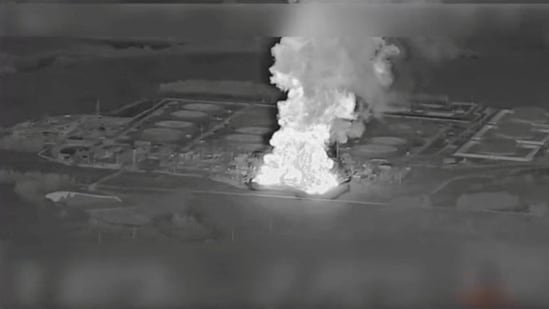“Before it was dangerous if you were static,” he said, noting that artillery usually hits buildings. “Now, it’s dangerous to be moving, because drones hit moving targets.”
Three-and-a-half years into the war, the conflict is growing deadlier for civilians, with explosive drones reshaping life in front-line towns and villages just as they have on the battlefield.
Some 1,674 civilians were killed or injured during July, the highest total of any month in more than three years, according to United Nations data. Drone attacks on civilians have risen sharply over the past year, the report found, with a record 67 civilians killed and 337 injured by short-range drones in July.
After years of lobbing munitions at buildings in front-line cities, Russia is now also targeting individual civilians and vehicles with explosive drones, creating a thick band of shattered towns and villages along the 750-mile front line where any movement is dangerous.
Yet, tens of thousands of civilians continue to live in front-line settlements. Despite the growing risks, many of them refuse to relocate.
Suliz, who lives with his wife in the south of Orikhiv—the most dangerous area, closest to the Russians—said about eight munitions have landed in his and his neighbor’s yard, including one massive glide bomb weighing at least a quarter-ton. The windows of the house are now boarded up and the roof covered with a tarp.
His adult children are constantly asking him to come live with them.
“My wife and I discuss it from time to time. We say, ‘Maybe we should go.’ But we decided to stay,” Suliz said, standing at a street market in town where he comes twice a week to get groceries. A munition crashed down several miles away as he spoke. “We built our house with our own hands. We can’t bring ourselves to abandon it.”
Orikhiv has been sitting along the southern front for almost the duration of the war, with the Russians within about 5 miles but unable to get much closer.
Around 1,000 civilians remain in Orikhiv and the surrounding villages, according to local officials, down from a prewar population of nearly 14,000.
Hardly a building remains unscathed. The town hall’s roof is caved in and covered with a tarp. The nearby church has been gutted, its steeple hanging askew on the splintered wooden dome. The street market in the city center remains open, though everything around it—including the trees—has been charred by Russian strikes.
Tetiana Kushnir, who sells fruits and vegetables at the market, said she now hears drones overhead every day. She sent her 13-year-old daughter to live in Zaporizhzhia in 2022, but refuses to leave herself. All the windows in her home have been blown out, as has the roof.
“Russians are hunting every vehicle—we don’t think they won’t touch us because we’re civilians,” Kushnir, 41, said. “If you hear the sound, you have to take cover and wait a while.” A concrete shelter has been installed just beside the market.
A sliver of Orikhiv still sometimes gets electricity, but gas and running water were cut long ago.
Oleksandr Billerys, deputy chief of the military administration for Orikhiv, said providing food, water and other essentials to the remaining residents has become steadily more difficult since drones became a menace. Several weeks ago, one attacked a volunteer distributing aid. The volunteer survived, but his vehicle was destroyed.
Local and regional authorities have installed antidrone netting over several streets in town and part of the highway that connects Orikhiv to Zaporizhzhia, the regional capital. Still, Billerys said, many volunteers will no longer come to town, leaving more of the burden—and the risk—for local officials like himself.
“Everyone should leave. People should not live here in these circumstances,” Billerys said. His own apartment here has been severely damaged, and he moved to Zaporizhzhia in 2022. “It ties the hands of our soldiers. They have to think, ‘If I fire from this place, there might be return fire and civilians could get hurt.’”
Getting civilians to leave, however, is a challenge. As in other front-line cities, children have been forced to evacuate. But Ukrainian officials have mostly held off mandating that adults clear out.
Most who remain in Orikhiv are older, many of them pensioners who have spent their entire lives here, like Mykola Hlushenko.
After a rocket ripped through his apartment last year—bursting through the front wall, over his head as he lay in bed, and out the back wall—Hlushenko, 73, and his wife moved to the basement of a neighboring building. They now live there with more than a dozen others from the neighborhood, all of them in their 60s and 70s.
Hlushenko hardly ever leaves the dirt-floor basement, which is lighted by a couple of bare lightbulbs hanging from the low ceiling. Water and other supplies are piled in the entryway. He occasionally steps outside to smoke or tend his vegetable garden, but is afraid to stray any farther.
“I feel very uncomfortable outside. I prefer to be down here,” he said. He goes to Zaporizhzhia to collect his pension, which amounts to less than $73 a month, and see family. “I can’t afford decent circumstances.”
Hlushenko’s sons—one in Poland, the other in Zaporizhzhia with their five grandchildren—beg their parents every day to evacuate, and offer to help them financially. His wife, Svitlana Hlushenko, is also eager to leave.
“If it were up to me, I would have left already. I’m tired of living in these conditions,” Svitlana Hlushenko said. “He tells me, ‘You go and I’ll stay.’ I’m a hostage in this situation, because I can’t just leave him here alone.”
Hlushenko gives reasons that are common among older people who refuse to evacuate: He says he can’t afford it; that he doesn’t want to burden his children; and that he can’t bring himself to leave his apartment, which he and his wife moved into in 1983.
Temporary housing is available for anyone who wants to leave Orikhiv, along with free food and other humanitarian aid, according to local officials.
But there is a shortage of long-term housing for internally displaced people, said Oksana Kuyantseva, a board member for East SOS, which conducts evacuations from front-line areas. Much of the housing that is available isn’t in great condition, she said. Some people evacuate and then don’t like living in a dorm with other evacuees and return.
It isn’t always possible to evacuate them a second time, Kuyantseva said, especially with the increasing range of drones putting volunteers at risk.
Svitlana Mandrych, the former deputy mayor of Orikhiv, questioned whether it was a good idea for front-line cities to keep providing services, like food and water distribution, to the remaining residents.
For the first year of the war, Mandrych stayed in town and set up a humanitarian-aid center at a local school, which offered meals, showers and a play area for children. Then in 2023, a glide bomb razed the school, killing seven people, injuring five others, and leaving one young boy an orphan. After that, Mandrych moved to Zaporizhzhia.
“It’s irresponsible to stay,” she said. “Sometimes, you need to abandon people for their own good. When you take care of people, they keep coming to get that care.”
Write to Ian Lovett at ian.lovett@wsj.com













